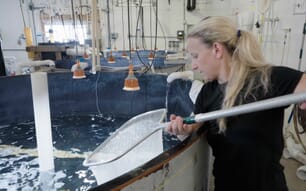A recent Johns Hopkins Center for a Livable Future report on seafood estimates that 52 to 62% of the total seafood loss (which is approximately 45% of all seafood we produce) occurs after the seafood is purchased and taken home (full study by Love et al. is here).
This is because we take our environmentally- and socially- responsibly produced food and let the food spoil and rot (as well as other reasons that the purchased food may be not consumed). We take all of that wonderful supply side sustainability, and squander it, or in harsher terms, we piss it away.
But what is not reported in the consumer-based food loss estimates is the actual pissing away of sustainability. More pointedly, consider protein. When we consume excess protein in amounts beyond what our bodies require, we don’t store it as is.
Excess protein is converted to glucose or fat, and the excess nitrogen is converted to urea, and expelled from the body. Hence biologically, we literally piss away our excess protein consumption. Figuratively, it is the effort to create less impactful food that we then discard and hence invalidate, or piss away, all prior eco-friendly effort.
Assuming we need 51g of protein per day (midpoint of female / male requirements respectively), each meal provides 1/3 of our protein, and fish averages 21.5% protein, then anything over 80g or approximately 3 oz is more than we biologically require. Eat a half pound fillet of fish and chips, and more than half what you eat will end up as biological waste.
We are in the midst of a sustainable food revolution. But this food revolution is overwhelmingly focused on supply-side sustainability. Consumers have a multitude of labels on packages that identify how the products held within were produced, and if these were made according to specific environmental and social sustainability criteria. We have reached this point in part by acknowledging that food production is one of the most significant determinants of environmental and social impacts.
All of these social and eco-labeling efforts to indicate more responsible foods will ideally modify the food system for the better. If it economically benefits producers to create more like products, then more will be created in these less deleterious ways, ultimately contributing to improving our food production system as a whole. Reducing impacts per unit of food produced will be critical as our collective food demands continue to soar with population headed to over 10 billion.
Creating supplies of food in a better, less environmentally impactful way is a key step toward greater sustainability and ultimately food security. Consumers have the right to ask for food produced in ways that are less damaging to the environment. While consumer demand plays a critical role in driving this supply side sustainability, just as important is how the food is used. Unfortunately, consumers appear to be less committed to using food in a way that supports greater sustainability.
Last year, the UN reported that approximately 1/3 global food production is tossed in the trash prior to being eaten, and the Johns Hopkins Center for a Livable Future report demonstrates that this waste may be greater for certain categories. Yet this estimate does not account for overconsumption in the food waste estimates.
If we were to include the systematic excess consumption of food by a portion of the human family with the definition of waste, it is likely that the total would approach 50%. Regardless of the true scale of food losses, all waste effectively compounds the impact our food production has on the planet. Consumers as well as producers have to be accountable for their actions when it comes to addressing the sustainability of our food systems.
The WHO estimated that the global per capita caloric production in the 1960s was 2400 kcals per person per day (a little more than the average biological need for an adult, and yes we acknowledge a current disparity in consumption patterns).However, the caloric production per person has grown, and will continue to do so, By 2030, the global average will exceed 3,000 kcal per person per day, and developed countries will be at 3500 kcal.
What does this mean for sustainability? From a Brundtland perspective, sustainable development is to provide for current peoples and not limit the needs of future generations. Under this definition, the global food system, as evidenced by daily caloric production, is on track. We are filling the caloric needs of current people, and in the future are anticipated to exceed those needs. Future needs are not being constrained by our current level of activity. But biologically, we have over extended our sustainability goals. The trend is for food growth (see the WHO calorie data) to occur faster than population growth. When this happens, as it currently does for US milk production, the excess product is discarded.
Growing the global food system to provide 30% more calories than required by all people by 2030 is not a sustainable trajectory. This will not only lead to increased waste (physically and biologically), but excessive caloric diets will burden the health system. This will in turn require new solutions to fix the food-based problems we cause through increased technology.
A food system based to optimize sustainability will produce a biologically appropriate amount of proteins and carbohydrates, and sector growth will mirror population growth, not exceed it. Although global food systems are a business, they can’t have unchecked growth. When this occurs, food is overproduced and blatantly wasted, or over consumed. Either way, supply side sustainability will be pissed away and will be for naught. It is not enough to shop with sustainability in mind. We must consume with those same goals.


